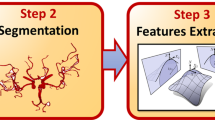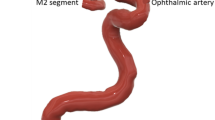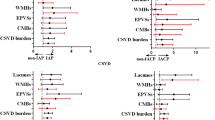Abstract
The associations between blood pressure parameters and intracranial vulnerable plaques have not been fully elucidated. The purpose of this study was to investigate the associations between systemic blood pressure parameters, as well as their variability, and intraplaque hemorrhage (IPH) in stroke patients with intracranial atherosclerosis. We retrospectively analyzed the high-resolution MRI data set of intracranial atherosclerosis from a comprehensive stroke center. The atherosclerotic plaque burden and presence of IPH in each vessel were obtained from vessel wall imaging. Blood pressure parameters in the first week of admission were used. The systolic blood pressure (SBP), diastolic blood pressure (DBP), pulse pressure (PP), and their variability (standard deviation [SD] and coefficient of variation [CV]) were compared between the IPH (+) and IPH (−) groups. Logistic regression analysis was used to demonstrate the correlations between different blood pressure parameters and IPH. The results indicated that SBP and PP were associated with multiple plaques and severe luminal stenosis after adjusting for confounders, with OR = 1.071, 95% CI: (1.044–1.098) and OR = 1.039, 95% CI: (1.019–1.060) for SBP and OR = 1.058, 95% CI: (1.027–1.089) and OR = 1.044, 95% CI: (1.019–1.070) for PP, respectively. SBP was associated with IPH after adjusting for cardiovascular risk factors, with OR = 1.021, 95% CI: (1.003–1.038), but not after correcting for plaque burden, with OR = 1.014, 95% CI: (0.996–1.032). No associations between blood pressure variability and atherosclerotic plaque burden or IPH were detected in this study. In conclusion, SBP is associated with IPH after adjusting for cardiovascular risk factors but not after further correction for atherosclerotic plaque burden. The association between blood pressure variability and intracranial atherosclerosis requires further study.
This is a preview of subscription content, access via your institution
Access options
Subscribe to this journal
Receive 12 print issues and online access
$259.00 per year
only $21.58 per issue
Buy this article
- Purchase on Springer Link
- Instant access to full article PDF
Prices may be subject to local taxes which are calculated during checkout

Similar content being viewed by others
References
Qureshi AI, Caplan LR. Intracranial atherosclerosis. Lancet 2014;383:984–98.
Kolodgie FD, Gold HK, Burke AP, Fowler DR, Kruth HS, Weber DK, et al. Intraplaque hemorrhage and progression of coronary atheroma. N. Engl J Med 2003;349:2316–25.
Gao P, Chen ZQ, Bao YH, Jiao LQ, Ling F. Correlation between carotid intraplaque hemorrhage and clinical symptoms: systematic review of observational studies. Stroke 2007;38:2382–90.
Takaya N, Yuan C, Chu B, Saam T, Underhill H, Cai J, et al. Association between carotid plaque characteristics and subsequent ischemic cerebrovascular events: a prospective assessment with MRI–initial results. Stroke 2006;37:818–23.
Takaya N, Yuan C, Chu B, Saam T, Polissar NL, Jarvik GP, et al. Presence of intraplaque hemorrhage stimulates progression of carotid atherosclerotic plaques: a high-resolution magnetic resonance imaging study. Circulation 2005;111:2768–75.
Hashimoto N, Hama S, Yamane K, Kurisu K. Carotid arterial intraplaque hemorrhage and calcification influences cerebral hemodynamics. Neurosurg Rev 2013;36:421–7.
Rothwell PM, Villagra R, Gibson R, Donders RC, Warlow CP. Evidence of a chronic systemic cause of instability of atherosclerotic plaques. Lancet 2000;355:19–24.
Selwaness M, van den Bouwhuijsen QJ, Verwoert GC, Dehghan A, Mattace-Raso FU, Vernooij M, et al. Blood pressure parameters and carotid intraplaque hemorrhage as measured by magnetic resonance imaging: the Rotterdam Study. Hypertension 2013;61:76–81.
Sun J, Canton G, Balu N, Hippe DS, Xu D, Liu J, et al. Blood pressure is a major modifiable risk factor implicated in pathogenesis of intraplaque hemorrhage: an in vivo magnetic resonance imaging study. Arterioscler Thromb Vasc Biol 2016;36:743–9.
Iwata S, Sugioka K, Fujita S, Ito A, Matsumura Y, Hanatani A, et al. Aortic arch atherosclerosis in patients with severe aortic stenosis can be argued by greater day-by-day blood pressure variability. Atherosclerosis 2015;241:42–7.
Li D, Zhao H, Chen X, Chen S, Qiao H, He L, et al. Identification of intraplaque haemorrhage in carotid artery by simultaneous non-contrast angiography and intraplaque haemorrhage (SNAP) imaging: a magnetic resonance vessel wall imaging study. Eur Radiol 2018;28:1681–6.
James PA, Oparil S, Carter BL, Cushman WC, Dennison-Himmelfarb C, Handler J, et al. 2014 evidence-based guideline for the management of high blood pressure in adults: report from the panel members appointed to the Eighth Joint National Committee (JNC 8). J Am Med Assoc 2014;311:507–20.
Liu LS. 2010 Chinese guidelines for the management of hypertension. Zhonghua Xin Xue Guan Bing Za Zhi. 2011;39:579–615.
Third Report of the National Cholesterol Education Program (NCEP). Expert panel on detection, evaluation, and treatment of high blood cholesterol in adults (adult treatment panel III) final report. Circulation 2002;106:3143–421.
Executive Summary of The Third Report of The National Cholesterol Education Program (NCEP). Expert panel on detection, evaluation, and treatment of high blood cholesterol in adults (adult treatment panel III). J Am Med Assoc. 2001;285:2486–97.
Mandell DM, Mossa-Basha M, Qiao Y, Hess CP, Hui F, Matouk C, et al. Intracranial vessel wall MRI: principles and expert consensus recommendations of the american society of neuroradiology. AJNR Am J Neuroradiol 2017;38:218–29.
Chimowitz MI, Lynn MJ, Howlett-Smith H, Stern BJ, Hertzberg VS, Frankel MR, et al. Comparison of warfarin and aspirin for symptomatic intracranial arterial stenosis. N. Engl J Med 2005;352:1305–16.
Li D, Dai W, Cai Y, Han Y, Yao G, Chen H, et al. Atherosclerosis in stroke-related vascular beds and stroke risk: a 3-D MR vessel wall imaging study. Ann Clin Transl Neurol 2018;5:1599–610.
Xu Y, Yuan C, Zhou Z, He L, Mi D, Li R, et al. Co-existing intracranial and extracranial carotid artery atherosclerotic plaques and recurrent stroke risk: a three-dimensional multicontrast cardiovascular magnetic resonance study. J Cardiovasc Magn Reson 2016;18:90.
Zhao X, Hippe DS, Li R, Canton GM, Sui B, Song Y, et al. Prevalence and characteristics of carotid artery high-risk atherosclerotic plaques in Chinese patients with cerebrovascular symptoms: a Chinese atherosclerosis risk evaluation II study. J Am Heart Assoc. 2017;6:e005831.
Stary HC, Chandler AB, Dinsmore RE, Fuster V, Glagov S, Insull WJ, et al. A definition of advanced types of atherosclerotic lesions and a histological classification of atherosclerosis. A report from the committee on vascular lesions of the council on arteriosclerosis, american heart association. Circulation 1995;92:1355–74.
Arnett DK, Boland LL, Evans GW, Riley W, Barnes R, Tyroler HA, et al. Hypertension and arterial stiffness: the Atherosclerosis Risk in Communities Study. ARIC Investigators. Am J Hypertens 2000;13:317–23.
Xiong H, Liu X, Tian X, Pu L, Zhang H, Lu M, et al. A numerical study of the effect of varied blood pressure on the stability of carotid atherosclerotic plaque. Biomed Eng Online. 2014;13:152.
Scuteri A, Rovella V, Alunni FD, Tesauro M, Gabriele M, Di Daniele N. An operational definition of SHATS (Systemic Hemodynamic Atherosclerotic Syndrome): role of arterial stiffness and blood pressure variability in elderly hypertensive subjects. Int J Cardiol 2018;263:132–7.
Sander D, Kukla C, Klingelhofer J, Winbeck K, Conrad B. Relationship between circadian blood pressure patterns and progression of early carotid atherosclerosis: a 3-year follow-up study. Circulation 2000;102:1536–41.
Vasunta R, Kesaniemi YA, Ylitalo A, Ukkola O. Nondipping pattern and carotid atherosclerosis in a middle-aged population: OPERA study. Am J Hypertens 2012;25:60–66.
Lau KK, Wong YK, Chan YH, Teo KC, Chan KH, Wai LL, et al. Visit-to-visit blood pressure variability as a prognostic marker in patients with cardiovascular and cerebrovascular diseases–relationships and comparisons with vascular markers of atherosclerosis. Atherosclerosis 2014;235:230–5.
Kumar A, Thompson EW, Lefieux A, Molony DS, Davis EL, Chand N, et al. High coronary shear stress in patients with coronary artery disease predicts myocardial infarction. J Am Coll Cardiol 2018;72:1926–35.
Aoyama R, Takano H, Suzuki K, Kubota Y, Inui K, Tokita Y, et al. The impact of blood pressure variability on coronary plaque vulnerability in stable angina: an analysis using optical coherence tomography. Coron Artery Dis 2017;28:225–31.
Reinhard M, Roth M, Guschlbauer B, Harloff A, Timmer J, Czosnyka M, et al. Dynamic cerebral autoregulation in acute ischemic stroke assessed from spontaneous blood pressure fluctuations. Stroke 2005;36:1684–9.
Madhok DY, Vitt JR, Nguyen AT. Overview of neurovascular physiology. Curr Neurol Neurosci Rep. 2018;18:99.
Acknowledgements
This study is supported by the Beijing Municipal Science & Technology Commission (Z171100001017019), Beijing Municipal Administration of Hospitals’ Ascent Plan (DFL20152201), Tsinghua University Initiative Scientific Research Program (20161080076), and Beijing Municipal Health Bureau project (2013-2-034).
Author information
Authors and Affiliations
Corresponding author
Ethics declarations
Conflict of interest
The authors declare that they have no conflict of interest.
Additional information
Publisher’s note Springer Nature remains neutral with regard to jurisdictional claims in published maps and institutional affiliations.
Rights and permissions
About this article
Cite this article
Song, X., Zhao, X., Liebeskind, D.S. et al. Associations between systemic blood pressure parameters and intraplaque hemorrhage in symptomatic intracranial atherosclerosis: a high-resolution MRI-based study. Hypertens Res 43, 688–695 (2020). https://doi.org/10.1038/s41440-020-0411-7
Received:
Revised:
Accepted:
Published:
Issue Date:
DOI: https://doi.org/10.1038/s41440-020-0411-7
Keywords
This article is cited by
-
The incomplete circle of Willis is associated with vulnerable intracranial plaque features and acute ischemic stroke
Journal of Cardiovascular Magnetic Resonance (2023)



